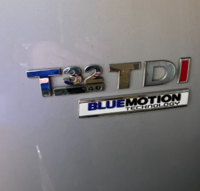You are using an out of date browser. It may not display this or other websites correctly.
You should upgrade or use an alternative browser.
You should upgrade or use an alternative browser.
Smart Alternator - all T6?
- Thread starter OllieGBR
- Start date
-
- Tags
- alternator
Good news how? If you are looking to install a leisure battery it is actually bad news because you're now going to need a DC-DC charger at great expense rather than a simple, cheap, split charge relay.
Good point, however I needed a DC-DC charger anyway I think as have solar panels. Still trying to work the whole thing outGood news how? If you are looking to install a leisure battery it is actually bad news because you're now going to need a DC-DC charger at great expense rather than a simple, cheap, split charge relay.

Take a pic of the starter battery terminals.
If there is no shunt on the neg terminal then it's a standard alternator.
Is there is a shunt then it's a smart alternator.
If there is no shunt on the neg terminal then it's a standard alternator.
Is there is a shunt then it's a smart alternator.
What issues are you having or what plans do you have that you need to know if it's a smart alternator? Not charging ( typical voltage when running is 14.4V) or leisure battery install (why go lead acid nowadays when lithium has so many advantages in the long run)?I have a 65 plate 2015 T6 4 Motion which is not Blue motion and does not take Addblue. On starting the battery read 12.7V and after 5 minutes it had risen to 13.45V. What further tests can I do to determine if this is a smart or traditional alternator?
The issue is that the leisure battery is running down more quickly than expected. I suspect that the alternator is not charging the leisure battery and that only the solar panel and the electric hook up are keeping the leisure battery topped up. The van was professionally converted in March 2023. I spoke with the converter who said that they thought the van had a traditional alternator so they fitted a Durite Heavy Duty Split Charge Relay. Before I take the driver's seat out to examine what they fitted, I wanted to do some basic checks. I will take a picture of the starter battery tonight. From memory it does have a smaller additional wire that could be a shunt on the neg terminal. I cannot access the leisure battery directly to test the volts and amps, so I will buy a current tester that I can attach to the main leisure battery fuse under the driver's seat. I am thinking of something like the Sealey Ta120 Current Tester 20A - but I would be very grateful for other suggestions.
Last edited:
Yes, that wire is the shunt connection.
I would go for something like this for testing, the clamp makes it a lot less likely for you to damage the tester if you don't know what you are doing.

Read the instructions, Set it to DC amps, zero the clamp then get it around the big wire going from starter battery positive to the leisure battery, this will tell you the charging current when the split charge relay engages ( if it does) I can be more than 20A so the sealey tester would likely go up in smoke or blow a fuse if you used that.
I would go for something like this for testing, the clamp makes it a lot less likely for you to damage the tester if you don't know what you are doing.

UNI-T UT210E Handheld RMS AC/DC Mini Digital Clamp Meter Resistance Capacitan ⊕I | eBay
Capacitance (F). Jaw opening. AC current (A). DC current (A). Resistance (Ω). VFC, low pass filter. Auto power off, low battery indication. 39.3mm x 26.5mm.
www.ebay.co.uk
Read the instructions, Set it to DC amps, zero the clamp then get it around the big wire going from starter battery positive to the leisure battery, this will tell you the charging current when the split charge relay engages ( if it does) I can be more than 20A so the sealey tester would likely go up in smoke or blow a fuse if you used that.
If your leisure battery is AGM or wet lead acid, the likely scenario is you have over discharged it at some point ( they don't like giving up more than half their rated capacity) and it has not recovered. The charging current should remain stable, dropping as the leisure battery charges, if it is a smart alternator van, the split charge relay was the wrong choice. You needed a DC-DC charger to get the best out of it.
If it is a smart alternator van, your starter battery should be an EFB or AGM for the system to work correctly ( and you should have start/stop button on the dash?)
If it is a smart alternator van, your starter battery should be an EFB or AGM for the system to work correctly ( and you should have start/stop button on the dash?)
Because the smart alternator cuts off charging when there's an excess of charge in the starter battery to reduce the load on the engine, in a split charge relay system every time the alternator shuts off the leisure battery can suffer from not getting enough charge. Often the van will only charge to 80% to allow for regeneration charging.
A DC-DC charger gets around this and makes sure it charges fully.
If you want to make best use of your leisure battery's reserves, a DC-DC charger is the best way forward. Plus, if you decide to go lithium in the future when the lead acid leisure battery dies, so long as you get one that will work with lithium, it's a simple setting change to get it to work ( and get twice as much capacity to boot)
You could try unplugging the shunt connection, this puts the van into normal charging mode and may solve your undercharging leisure battery problem, but it will light the MIL on your dash because it thinks something is wrong.
A DC-DC charger gets around this and makes sure it charges fully.
If you want to make best use of your leisure battery's reserves, a DC-DC charger is the best way forward. Plus, if you decide to go lithium in the future when the lead acid leisure battery dies, so long as you get one that will work with lithium, it's a simple setting change to get it to work ( and get twice as much capacity to boot)
You could try unplugging the shunt connection, this puts the van into normal charging mode and may solve your undercharging leisure battery problem, but it will light the MIL on your dash because it thinks something is wrong.
The best of the best at the moment is the Victron Orion XS 50a. Most efficient, 50a charging, and Victron are about the best in the business.
The logical place to put it is where the durite relay is now
Thanks for all your help. Whilst I am changing the Durite VSR for the Victron DC-DC, I might take the opportunity to replace the leisure battery. It is a bit crowded under the driver's seat (see attached picture) and the existing battery is physically smaller than the usual 100Ah / 110Ah battery, probably taking up two thirds of the width of the space. Maybe it is around 85Ah or even smaller. Any recommendations for a capacity, make and brand of replacement battery, and whether to go lead acid or lithium?


If you are replacing a good chunk of the leisure electrics then it's definitely worth thinking about going LiFePo based - the initial cost is a bit higher but you'll likely be replacing a lead acid battery in about 2-3 seasons and LiFePo will give you twice the usable capacity.
However you will need to make sure all your chargers are lithium capable (so any 240v chargers on the EHU and any solar chargers)
Also don't go cheap on the lithium battery, get a well known brand with low temperature charge protection.
However you will need to make sure all your chargers are lithium capable (so any 240v chargers on the EHU and any solar chargers)
Also don't go cheap on the lithium battery, get a well known brand with low temperature charge protection.
Similar threads
- Replies
- 18
- Views
- 1K
- Replies
- 11
- Views
- 998
- Replies
- 8
- Views
- 1K
- Replies
- 0
- Views
- 157



